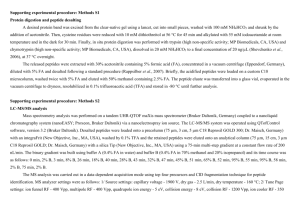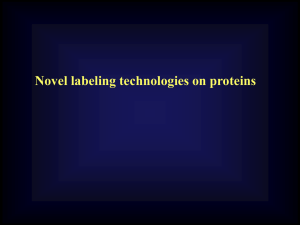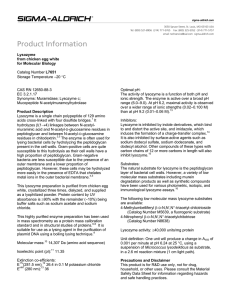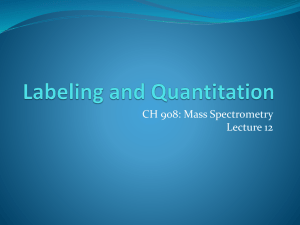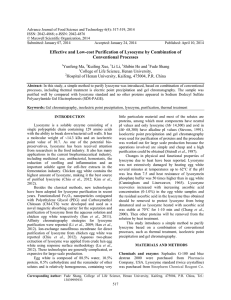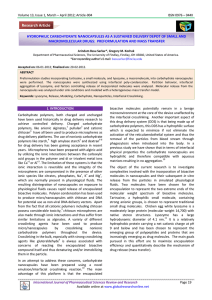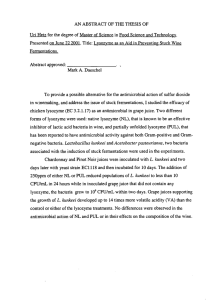RCM_4060_sm_SupportingInformation
advertisement
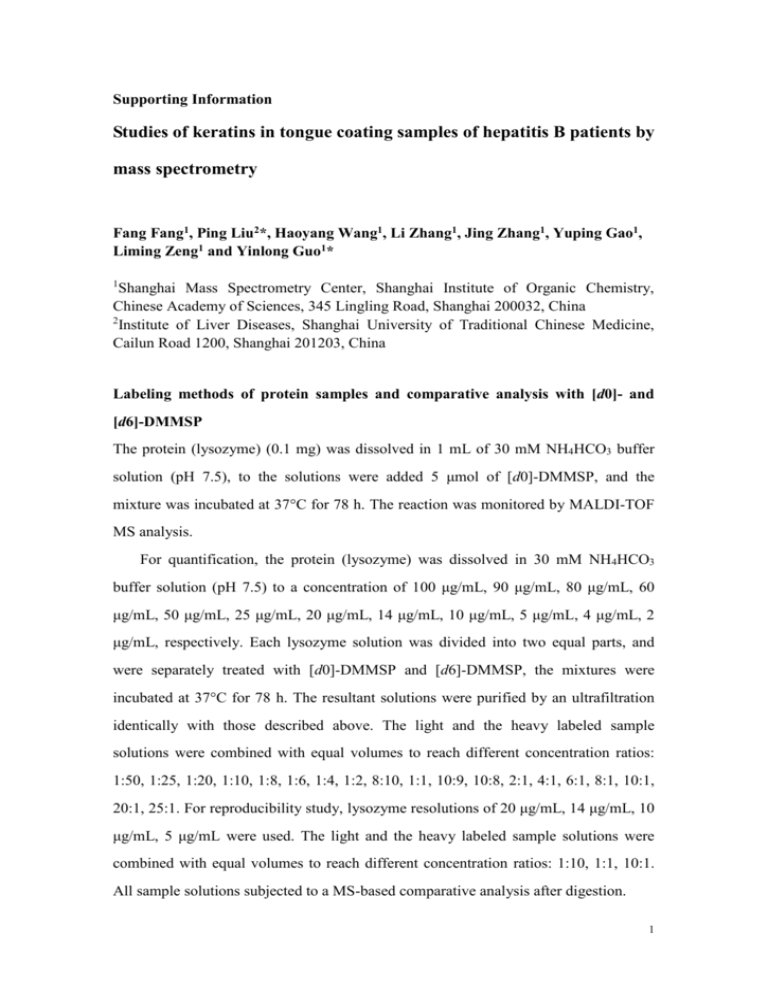
Supporting Information Studies of keratins in tongue coating samples of hepatitis B patients by mass spectrometry Fang Fang1, Ping Liu2*, Haoyang Wang1, Li Zhang1, Jing Zhang1, Yuping Gao1, Liming Zeng1 and Yinlong Guo1* 1 Shanghai Mass Spectrometry Center, Shanghai Institute of Organic Chemistry, Chinese Academy of Sciences, 345 Lingling Road, Shanghai 200032, China 2 Institute of Liver Diseases, Shanghai University of Traditional Chinese Medicine, Cailun Road 1200, Shanghai 201203, China Labeling methods of protein samples and comparative analysis with [d0]- and [d6]-DMMSP The protein (lysozyme) (0.1 mg) was dissolved in 1 mL of 30 mM NH4HCO3 buffer solution (pH 7.5), to the solutions were added 5 μmol of [d0]-DMMSP, and the mixture was incubated at 37°C for 78 h. The reaction was monitored by MALDI-TOF MS analysis. For quantification, the protein (lysozyme) was dissolved in 30 mM NH4HCO3 buffer solution (pH 7.5) to a concentration of 100 μg/mL, 90 μg/mL, 80 μg/mL, 60 μg/mL, 50 μg/mL, 25 μg/mL, 20 μg/mL, 14 μg/mL, 10 μg/mL, 5 μg/mL, 4 μg/mL, 2 μg/mL, respectively. Each lysozyme solution was divided into two equal parts, and were separately treated with [d0]-DMMSP and [d6]-DMMSP, the mixtures were incubated at 37°C for 78 h. The resultant solutions were purified by an ultrafiltration identically with those described above. The light and the heavy labeled sample solutions were combined with equal volumes to reach different concentration ratios: 1:50, 1:25, 1:20, 1:10, 1:8, 1:6, 1:4, 1:2, 8:10, 1:1, 10:9, 10:8, 2:1, 4:1, 6:1, 8:1, 10:1, 20:1, 25:1. For reproducibility study, lysozyme resolutions of 20 μg/mL, 14 μg/mL, 10 μg/mL, 5 μg/mL were used. The light and the heavy labeled sample solutions were combined with equal volumes to reach different concentration ratios: 1:10, 1:1, 10:1. All sample solutions subjected to a MS-based comparative analysis after digestion. 1 Results The mass spectra for quantitative analyses of a Cys-containing peptide (WWCNDGR) from lysozyme digestion are shown in Fig. S1. The combination of ‘light’ and ‘heavy’ labeled samples gave a 6 Da difference in the molecular weight, which can be visually identified (between m/z 1074.4 and 1080.4 for WWCNDGR in Fig. S1). The intensity ratios of the monoisotopic peaks existing in pairs were calculated and proven consistent with the actual sample concentration ratios to a certain extent from 0.1 to 10 (Fig. S2). Peptides containing cysteine, lysine, and tyrosine residues (KVFGR, HGLDNYR, RHGLDNYR, CKGTDVQAWIR, WWCNDGRTPGSR, KIVSDGNGMNAWVAWR) were also observed clearly in pairs (Table S1). Their relative intensity ratios provided auxiliary and reliable information for more accurate quantitative analysis. Here, the peptide WWCNDGR was chosen and the relative errors of quantitative analysis were calculated (Fig. S2), which show excellent values under 5% in certain concentration ratios from 0.1 to 10. The quantitative result could also be obtained from any of the other labeled peptides. Figure S1. Results from quantitative isotopic labeling at the peptide level (WWCNDGR differentially labeled with ‘light’ and ‘heavy’ reagents). (A) The theoretical light-to-heavy ratio for this peptide was 0.1(L/H) while the calculated ratio was 0.097 (L/H). (B) The theoretical light-to-heavy ratio for this peptide was 4 (L/H) while the calculated ratio was 4.186 (L/H). 2 Figure S2. Relative errors of labeling quantitative analysis of lysozyme solutions. Table S1. Labeling peptides identified from digests of lysozyme modified by [d0]-/[d6]-DMMSP Observed Matched peptides from m/z database Number No. of No. of Theoretic [d0]-DM [d6]-DM No. of cysteines tyrosines al m/z lysines MSP MSP Position Sequence (before labeling labeling labeling) 1 744.4 750.4 606.4 19-23 KVFGR 0 1 0 No. of added tags 1 2 1012.4 1018.4 874.4 33-39 HGLDNYR 0 0 1 1 3 1074.4 1080.4 936.4 80-86 WWCNDGR 1 0 0 1 4 1552.7 1564.7 1276.6 133-143 1 1 0 2 5 1572.5 1578.5 1434.6 80-91 1 0 0 1 0 1 0 1 CKGTDVQA WIR WWCNDGR TPGSR KIVSDGNG 6 1941.7 1947.7 1803.9 115-130 MNAWVAW R 3
